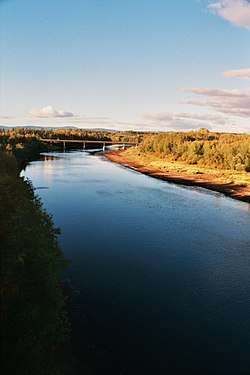Nechako River
The Nechako River /nəˈtʃækoʊ/ arises on the Nechako Plateau east of the Kitimat Ranges of the Coast Mountains of British Columbia, Canada, and flows north toward Fort Fraser, then east to Prince George where it enters the Fraser River. "Nechako" is an anglicization of netʃa koh, its name in the indigenous Carrier language which means "big river".
| Nechako River | |
|---|---|
 The Nechako River and Highway 16 bridge, near Fort Fraser | |
| Etymology | Dakelh term meaning "big river"[1] |
| Location | |
| Country | Canada |
| Province | British Columbia |
| City | Prince George |
| Physical characteristics | |
| Source | Nechako Plateau |
| Mouth | Fraser River |
• location | Prince George |
• coordinates | 53°55′2″N 122°42′53″W[2] |
• elevation | 559 m (1,834 ft)[3] |
| Length | 516 km (321 mi)[1] |
| Discharge | |
| • location | gage at Isle Pierre[4] |
| • average | 277 m3/s (9,800 cu ft/s)[4] |
| • minimum | 40.8 m3/s (1,440 cu ft/s) |
| • maximum | 1,180 m3/s (42,000 cu ft/s) |
The Nechako River's main tributaries are the Stuart River, which enters about 45 kilometres (28 mi) east of Vanderhoof, the Endako River, the Chilako River, which enters about 15 kilometres (9 mi) west of Prince George, and the Nautley River, a short stream from Fraser Lake. Other tributaries include the Cheslatta River, which drains Cheslatta Lake and enters the Nechako at the foot of the Nechako Canyon via Cheslatta Falls, near Kenney Dam and the Nechako Reservoir.
History
The expedition of Alexander MacKenzie went past the mouth of the Nechako in 1793, curiously without observing it. The first European to ascend the Nechako was James McDougall, a member of Simon Fraser's expedition, in 1806.
Nechako Reservoir
The Nechako is one of the main tributaries of the Fraser River, although half[5] of its flow was diverted through the Coast Mountains to the Kemano generating station at sea level on the Gardner Canal, 858 metres (2,815 ft) below the reservoir's intakes, which supplies power to the aluminum smelter at nearby Kitimat. The main reservoir of the Nechako power diversion is called the Nechako Reservoir or Ootsa Lake Reservoir, but there are many subnames for different parts of the lake because its conversion into a reservoir involved the amalgamation of chains of lakes, the largest of which were Eutsuk Lake and Natalkuz Lake, which form the south arm of the reservoir. The reservoir's alternate name comes from Ootsa Lake, now merged into the north arm of the reservoir but originally flowing into the Oosta River, a tributary of the Nechako. Other lakes also merged into the north arm are Whitesail Lake and Tahtsa Lake, with the correspondingly-named rivers connecting them now flooded and renamed Whitesail Reach and Tahtsa Reach. The Quanchus Range is located between the two arms of the reservoir.
The damming of the Nechako in 1952 and the consequent massive reduction in flow has been the source of considerable political controversy. The Cheslatta Carrier Nation, a subgroup of the Dakelh or Carrier people, were flooded out by the creation of the reservoir and forced to abandon their homes with only two weeks' warning. The increase in water temperature caused by the reduction in flow has been an ongoing problem for the salmon run on the Fraser and Stuart Rivers as well as the Nechako. Populations of White Sturgeon may have also been affected as studies show an unnatural decline in late-juvenile/early adult populations of the species.
See also
- List of tributaries of the Fraser River
- List of British Columbia rivers
References
- "Fraser Basin Watersheds". Fraser Basin Council. Retrieved 4 August 2013.
- "Nechako River". BC Geographical Names.
- Mouth elevation derived from ASTER Global Digital Elevation Model, using GeoLocator, and BCGNIS source coordinates.
- "Archived Hydrometric Data Search". Water Survey of Canada. Archived from the original on 24 December 2010. Retrieved 4 August 2013. Search for Station 08JC002 Nechako River at Isle Pierre
- T D French, P A Chambers. "Reducing flows in the Nechako River". Canadian Journal of Fisheries and Aquatic Sciences. doi:10.1139/f97-133. Cite journal requires
|journal=(help)
Further reading
- Christensen, Bev (1995) Too Good to be True. Vancouver: Talonbooks. (A history of the Kemano project, which dammed the Nechako.)
- Giesbrecht, Jean Clark (1994) Heritage Lost: A People's History of the Ootsa Lake Region 1905-1955. Likely, BC: Quesnel Lake Publishing. (Contains an account of the flooding caused by the construction of the Kemano Project.)
- Wood, June (2013). Home to the Nechako: The River and the Land. Heritage House Publishing Co. ISBN 978-1-927527-13-9. Retrieved 4 August 2013.
External links
- BC Lakes and Rivers
- "Engineers Invade Another Wilderness - Huge Canadian Power Project Marks 20th Century Frontier Boom" , by Richard Neuberger detailed 1951 Popular Science article on the Kemano Hydro Project